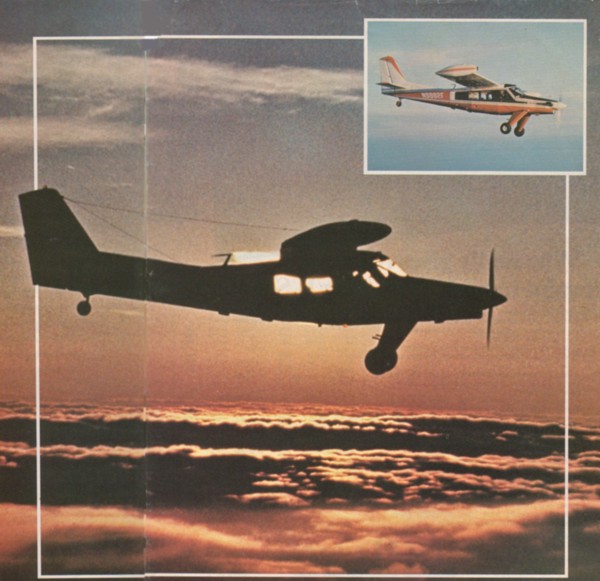|
tem. The SFAs provides up to 55 pounds forward push at 42 knots IAS; sometime up to 100 under certain conditions-and leaves a newcomer to the Stallion feeling he's been suckered into an arm-wrestling match with King-Kong. There was the same need to keep the controls coordinated. The Stallions are rudder airplanes. The wing spans 41 feet and the bird is 39 feet, seven inches long The fin and rudder are eight feet high. That's alot of mass moving in the sky, and at low speeds and with the PT6A pumping torque into the 101 inch prop, you can get yourself in an awful mess unless you fly the rudder just right. In fact, if you fly the Stallion really in the STOL mode-right on the bottom fringes of performance parameters-you are going to be a very busy man. It will require every bit of your concentration. And you will get an awful lot of healthful exercise. It's significant that the Stallion pilot notes, as written by Helio, says:"It should be emphasized here that the Stallion, during take-offs and landings, must be masterfully controlled by the pilot," and goes on to say that any incipient swing demands "immediate corrective action." However, it's amazing that the airplane is not much harder to handle than it is. A Stallion pilot can expect to go from 680 hp to zero hp to minus something on any trip-which should do weird things to directional control in all three axes. In fact, there's a surprising lack of torque effect in any axis or flight mode to me. Not everyone has felt this way. Helio claims its airplanes won't stall. And they won't; not really. But you can get some hellacious sink rates. And you can just about run the Stallion out of rudder in the air, holding the nose up under power until it finally swings leftward despite full right rudder. In 91F you can work the airplane down to 38 KIAS at 60 percent power (450 hp) but at that point it becomes extremely unstable in the roll axis. Hold it there and work the nose just a tad higher and it will finally fall off on a wing. The FAA defines the stall in these types as the point where they become elevator limited. In both the AU-24 and original 550A, this is about 38 knots, or 45 mph, clean; 36/42 with flaps down. We didn't do it, since this was a private-venture airplane and not a factory demonstrator, but I knew what Davis was talking about when he says at the break he was almost at the top of a hammerhead. I recalled a similar experience in the 550A. Davis also says with more throttle, you can end |
up in what amounts to a vertical torque roll, with the airplane tailsliding, corkscrew fashion back down its own flight path. The Stallion is tough, but it's not designed to do aerobatics. We also tried a maximum performance ground attack, involving a wingover into a 50-degree dive with the prop in deep beta once, but we dropped that because it made Davis nervous about the prop and because he said in practice it wasn't used much in combat due to lateral snaking. We were indicating 80 knots and descending 3,600 fpm. That's the beauty of a turboprop. Back off the power lever to 30 percent at 100 mph and the prop blades actually begin holding you back. It's like throwing out the anchor. You don't have to fly the Stallion down at the hairy end of the performance envelope , of course. If you fly it like a normal airplane, that's what you've got. And one with a satisfyingly high degree of performance. This is the way the military flew it, using the STOL ability simply to fly heavy loads safely out of high, hot areas. On the other hand, fly it light and you get impressive speeds. Davis recalls in his flight test program "I've hit 225 knots (260 mph) easy on the deck on a cool day. It'll accelerate to that." He recalled a series of five runs at 50 feet AGL (approximately 1,000 MSL) on a 50-degree day. The plane was timed at 205-210 knots (236-242 mph) on every run, and he added, "Yesterday (July 9, 1978) at 12,500 MSL , I was truing 214 mph on a very hot day during a cross-country over Arkansas. And we've had it to 379 TAS, coming out of 24,000 MSL, indicating 235 knots in about a 30-degree dive, full throttle" during the test program. Normal cruise is considered to be 206 mph (75 percent power) to 160 mph (60 percent). That's not bad for a single-engine eight-place airplane with a 2,800-pound useful load. And, among other changes, Davis got the official ceiling upped from 20,000 to 24,000 feet and suspects it will go to 30,000 feet. He notes he was still getting 800 fpm rate of climb at 5,800 pounds and 20,000 feet. It's really cheap to fly, too. Fuel costs $35 per hour, and Davis figures a sinking fund of $10 per hour on the engine. "You have less maintenance per hour on this airplane than you do on anything else. Ugly or not, AU-24 or civilian 550A, the Helio Stallion is a thoroughbred performer. And it's a shame that production has stopped. But, if you just can't live without one-well 91F is for sale. And the price? Only $287,000, a bargain. The first airplane sold for over $300,000! |
